Hooray! You have erected the walls of the future house, equipped the roof and thought. Heating a private house with your own hands - is it possible? What will be the heating scheme? Although, most likely, you study the question in advance. So let's decide now what kind of heating will be in the house.
The heating method is almost certainly chosen, but let's spend a couple of minutes considering an alternative, what if? ..
Types of heating.
Geo- and solar heating. Heating the house with the heat of the earth and the energy of the sun. These methods are in the overwhelming majority of cases inapplicable, they will pay off for a long time, so we will not dwell on them.
Steam heating. With the help of the boiler, water is heated until it turns into steam, which is fed through the main pipes to the radiators. There it gives off heat, and returning to a liquid state, it goes back into the boiler. This system is used in enterprises. For a private house, it is unacceptable due to its cumbersomeness. And you shouldn't forget about safety. The steam boiler is not entirely reliable, and the steam temperature is 115 ° C.
Air, infrared heating. A heat source, such as an infrared radiator, heats the air, which is directed either directly or through air ducts into the premises. The heat sources are powered by natural gas. Fans are used to improve air circulation. It is used for heating workshops at enterprises; it is not suitable for a residential building. Dry air will not create comfort in the home. And such a system is not cheap.
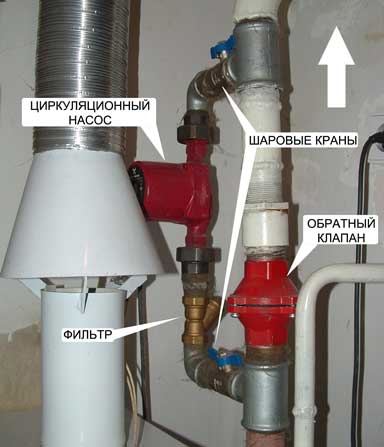
Now closer to the realities of life.
Electric heating. To create heating, convectors, warm floors, electric infrared heaters and their combinations are used.
Convectors
- these are the same radiators, only heated with electricity. The convector has a metal body, the surface temperature does not exceed 60 ° C. On the body there are grilles that direct the air flow down and to the sides. Convectors are protected from overheating and voltage surges.
Creating a heating scheme using convectors is cheaper than water heating, because there is no boiler or mains. In addition, there are movable convectors, this allows you to change the heating scheme.

The simplest calculation of the required number of devices is based on the area of the house, 100 W of thermal power is required per 1 square meter of the room. For example, the area of a house is 200 sq. m. This means that a thermal power of 100 W x 200 = 20,000 W is required. You have chosen a 2000 W convector. Number of products 20,000 / 2000 = 10 pieces.
Warm floor
- heat the premises from the bottom up. Heat flows in the right direction and evenly over the entire area. For the installation of a warm floor, a system of heating elements, most often electric, is created inside the screed. The electrical element is a tube or conductive film. For the sake of justice, let's say that underfloor heating can be water.
Advice. It is not necessary to install underfloor heating in a multi-storey building. In the event of a leak, there is no hassle, opening them is a problem, plus repairs to flooded neighbors from below.
Infrared ceiling heaters ... An interesting new technical solution for space heating. Heat from a heater located at the top of the room is not transferred to the air, but directly to objects in the room. Heaters of this principle have a high efficiency. Their location does not reduce the area of the room.
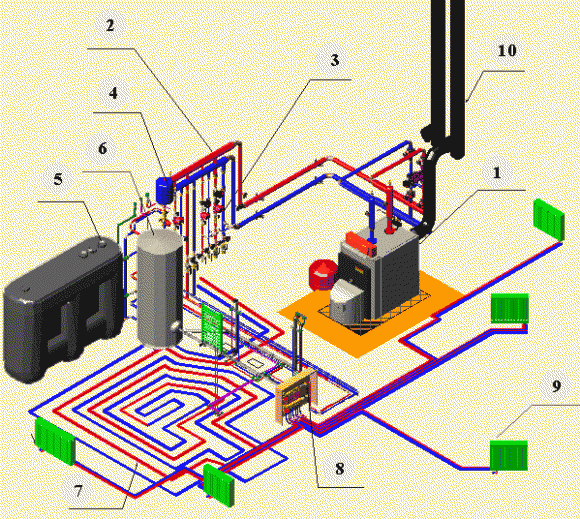
In conclusion, a couple of fly in the ointment for electric heating. Heating a house with electricity is more expensive than gas heating and interruptions in electricity are much more common than with gas.
Water heating. The system is simple, reliable and cheap to operate. One drawback is the cost of creating it. Further in the article we will consider it exactly.
Water heating. Operating principle. Structural elements.
The circuit is a closed loop built around a heater - boiler. Water radiators are used as heat transfer elements. Water, heated in the boiler to about 75 ° C, enters the heating circuit. By giving off heat to the surrounding air with the help of radiators, the cooled water flows back into the boiler for further heating. Further, the cycle is repeated.

Depending on the type of fuel, boilers are divided into:
- gas,
- solid fuel,
- on liquid fuel,
- electrical.
Gas boilers
Most Popular. This is due to their economy and the relative cheapness of natural gas. The range of models allows you to choose a boiler for every taste, for solving any task. Disadvantages - the installation and installation of the boiler can only be carried out by a specialized organization. The second drawback is that your area must be gasified, it is very expensive to use gas in cylinders.
Solid fuel boilers
fired with coal, peat, pallets. The downside is obvious - the fuel must be constantly loaded and stored somewhere. But if there is no gas, then the choice decreases.
Oil fired boilers
have a number of serious disadvantages. The main one is the cost of fuel. And the cost is growing every day. In addition, a very noticeable odor is emitted when fuel is burned. A special storage tank is required for storage.
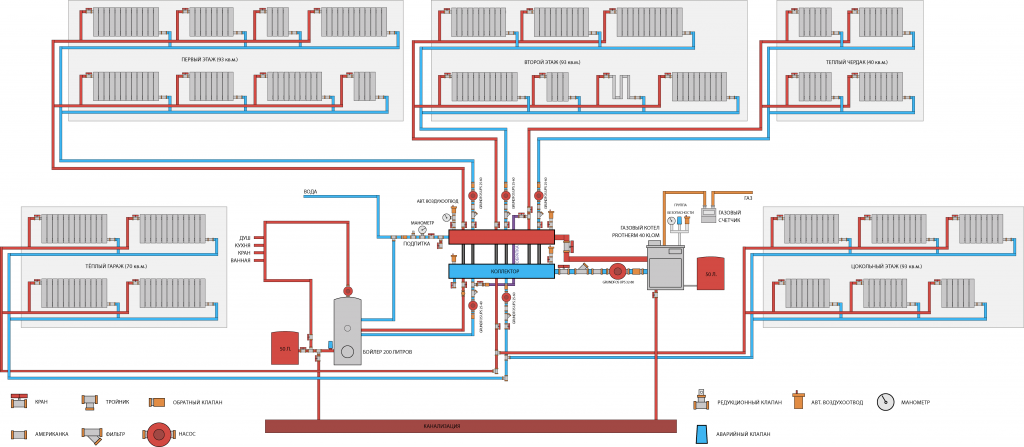
Perhaps, when choosing a boiler, a table of calorific values of different types of fuel will help you. 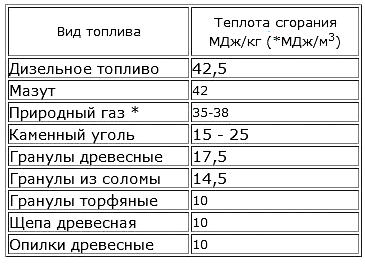
Electric boilers
- are connected to the centralized electrical network. The disadvantage is the high fuel cost compared to a gas boiler.
A few words about how much boiler power you need. If you do not want to go into cumbersome calculations, then it can be estimated using the table.
House area, sq. m. Boiler power, kW
60-200 up to 25
200-300 25-35
300-600 35-60
600-1200 60-100
There are boiler models that can use several types of fuel. For example, gas and coal.
For the device of the line (loop) through which water will circulate, steel, stainless and polypropylene pipes are used. The latter became the undisputed leader.
They are cheap, with enviable heat resistance and durability sufficient for heating a residential building. It is better to purchase reinforced polypropylene pipes, they are durable and have a lower coefficient of linear expansion when heated, which means they do not deform during service.

Water heating radiators are:
- cast iron,
- steel,
- aluminum,
- bimetallic.
Cast iron
- the most deserved type of radiators. They heat up slowly, but keep warm well. They are very heavy, brittle and somewhat more expensive than steel ones, but their service life is up to 50 years and are not afraid of rust.
Steel
- budget type of radiators. They have high efficiency and low price. Warm up quickly. Minus - they are afraid of corrosion.
Aluminum
radiators - lightweight, mounted on less durable brackets compared to cast iron and steel. They warm up quickly, and surpass other heating devices in terms of heat transfer. Cheapness and modern design attract a lot of supporters of this type of radiator. The disadvantages include a short service life (up to 15 years), fear of corrosion and water hammer.
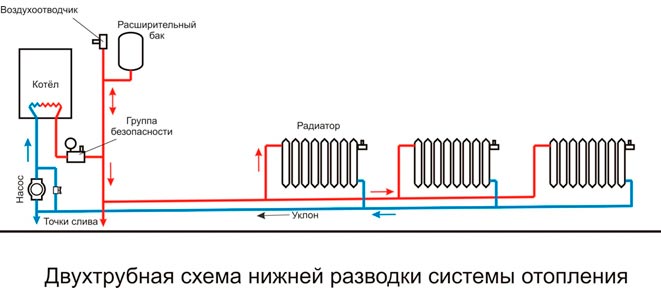
Bimetallic
- combine the strength of steel radiators and the heat transfer of aluminum. They are a tubular steel structure, sometimes reinforced with a steel frame, on which an aluminum shell is placed. They warm up quickly, give off heat well, hold water hammer, the richness of modern design, ease of installation - this is a list of their advantages. The downside is the high price.
Water heating schemes.
Single-circuit system. The water heated by the boiler flows sequentially into all radiators, alternately losing the temperature in each of them. In the latter, it may no longer be low enough.
The advantage is the cheapness of the circuit. Only one contour is created, labor and material costs are lower. The disadvantage is the uneven heating, due to the sequential scheme. To some extent, we can eliminate the disadvantage by forced circulation using a pump. More on this a little further.

Double-circuit scheme. The heated water enters at once into all radiators in parallel, the cooled water flows along a different circuit. By installing taps on each of the radiators, we get the opportunity to exclude any element from the system.
The main advantage is uniform heating of all radiators. The disadvantage is that the creation of the second circuit will be more expensive.
Collector circuit. In it, each radiator has its own supply and return circuits, which are connected by a collector. 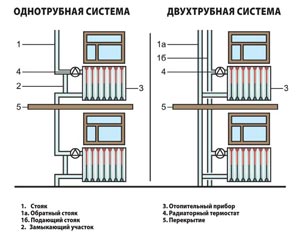
Advantages - aesthetic appearance, the ability to regulate the temperature in any room using a switch cabinet (electronic control is possible).
Forced circulation scheme. A distinctive feature is the use of a water pump. The pump creates additional pressure in the system, providing an even flow to the second and third floors of your home. The system is undemanding to the slope of the pipes.
Heating system installation.
In the process of building a house, it is necessary to provide technological holes for laying heating pipes. The sequence of installation is determined by your desire and construction technology.
First, we place the boiler.
Attention! Once again, we remind you that only a specialized organization can connect the boiler to the gas network.
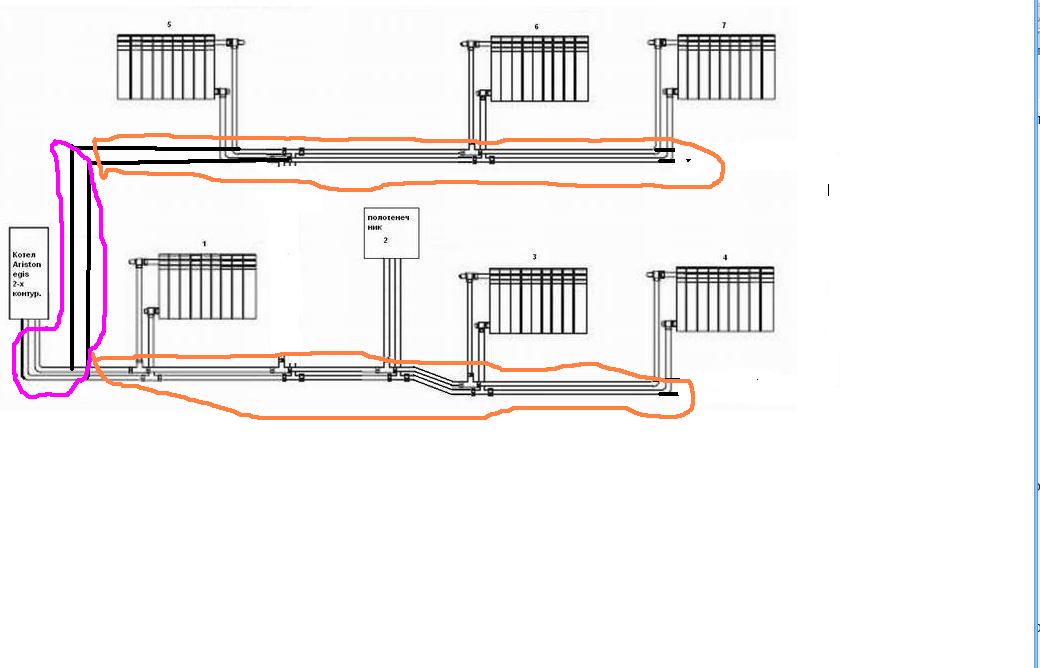
We install radiators as soon as the walls are finished. We set the radiators strictly horizontally, according to the level.
Did you know that the noise of the batteries, which sometimes interferes with sleep, is caused by the distortion of the radiators? The skew creates an air pocket that generates this "music".



